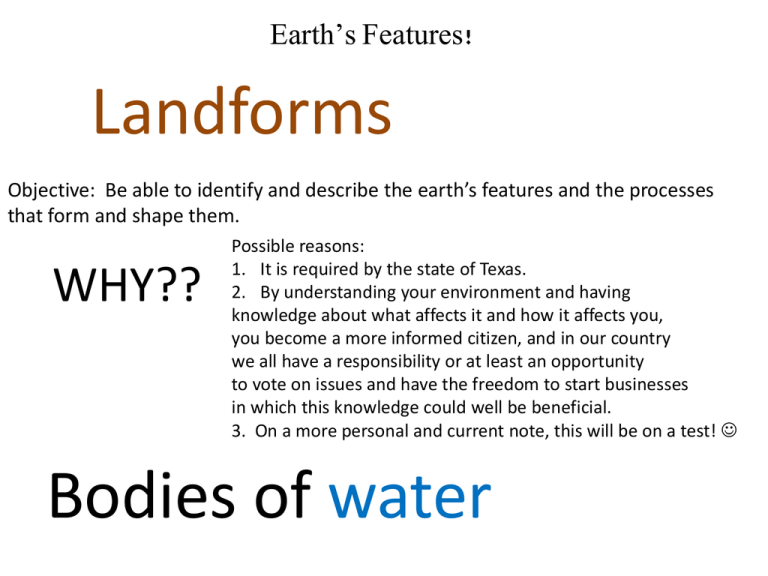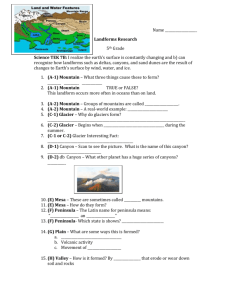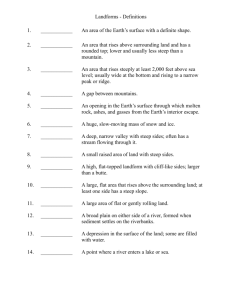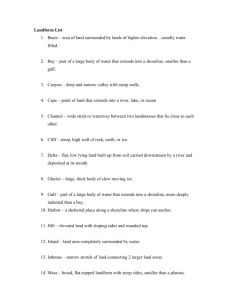
Earth’s Features!
Landforms
Objective: Be able to identify and describe the earth’s features and the processes
that form and shape them.
WHY??
Possible reasons:
1. It is required by the state of Texas.
2. By understanding your environment and having
knowledge about what affects it and how it affects you,
you become a more informed citizen, and in our country
we all have a responsibility or at least an opportunity
to vote on issues and have the freedom to start businesses
in which this knowledge could well be beneficial.
3. On a more personal and current note, this will be on a test!
Bodies of water
What do you already know? What do you need to know?
Get your pen and paper ready. The next few slides are
an effort to evaluate knowledge you may already have
and also to introduce things you don’t already know.
You will be given a definition or description of a landform
or body of water. Practice note-taking by bulleting the
important information from the slide, and if you know the
feature being described, label it!
The definition will be followed by a picture of the actual
feature– some of you will figure out the feature from this
slide. Try to add a quick sketch to your notes.
A natural elevation of the earth's
surface having considerable mass,
generally steep sides, and a height
greater than that of a hill.
*considerable mass?
Mountain
*steep sides?
*higher than a hill?
Put a bunch of them together and you have
a mountain……. range
A narrow channel joining
two larger bodies of water.
STRAIT
Large body of water.
Small body of water.
Another large body of water.
A strip of land
projecting into
a body of water.
body of water
Cape
strip of land
A narrow strip of land
connecting two larger
masses of land.
large piece of land
isthmus
(try saying that
five times really fast!)
another large piece of land
Public Domain. Suggested Credit: NASA/GSFC/METI/ERSDAC/JAROS, and U.S./Japan ASTER
Science Team
A usually triangular mass of sediment,
especially silt and sand, deposited at
the mouth of a river.
*They are usually crossed by numerous
streams and channels and have
exposed as well as submerged areas.
delta
Related termsEstuary1. The wide lower course of a
river where it flows into the
sea. Estuaries experience
tidal flows and their water is
a changing mixture of fresh
and salt.
2. An arm of the sea that
extends inland to meet the
mouth of a river.
Mouth of a riverPlace where a river flows
into a larger body of water.
World History moment…. A Greek letter sits at the mouth of many rivers. Notice the
resemblance between the island formed by sediment at the mouth of a river such as
the Nile and the triangular shape of their letter delta. The Greeks gave the name delta
to such an island. English borrowed this sense from the Greek, although the word delta
appeared first in English as the name of the letter, in a work written possibly around 1200.
The sense “alluvial deposit” is not recorded until 1555 when delta is used in reference to the
Nile delta. The American Heritage® Dictionary of the English Language, Fourth Edition copyright ©2000 by
Houghton Mifflin Company. Updated in 2009. Published by Houghton Mifflin Company. All rights
reserved.
Greek letter delta………..
An elongated lowland between
ranges of mountains, hills, or
other uplands, often having a
river or stream running along the
bottom.
Valley
A large area of a sea or
ocean partially enclosed
by land, especially a long
landlocked portion of sea
opening through a strait.
Gulf
A group of many
islands in a large
body of water.
island
archipelago
another
island
and another one
okay, one more!
and finally
A ring-like coral island
and reef that nearly or
entirely encloses a
lagoon.
atoll
lagoon
A long, narrow, deep
inlet of the sea
between steep slopes.
fjord
A steep slope or long cliff
that separates two
relatively level areas of
differing elevations.
Also described as a steep cliff or slope.
escarpment
A large or high
waterfall.
Also a cataract…
Cataract
Opacity of the lens or
capsule of the eye, causing
impairment of vision or
blindness
memory association…. falling
water….
A stream that flows into a larger
stream or other body of water.
Larger river
Smaller river
Tributary
A large piece of land
surrounded by water
on three sides.
Peninsula
A huge mass of ice slowly
flowing over a land mass.
Glacier
A flat area resulting from
repeated deposits of alluvial
material by running water.
Alluvial plain
Note: alluvial soil - a fine-grained fertile soil deposited by
water flowing over flood plains or in river beds.
An artificial waterway or
artificially improved
river used for travel,
shipping, or irrigation.
Panama Canal
It’s a man made feature across what
kind of landform?????
1. A hill that rises abruptly from the
surrounding area and has sloping sides
and a flat top.
2. A broad, flat-topped elevation with
one or more cliff like sides, common in
the southwest United States.
Mesa? 2.
Butte? 1.
An elevated, comparatively
level expanse of land; a
tableland.
Plateau
A long, relatively narrow
island running parallel to
the mainland.
mainland
Long narrow island
barrier island
A body of water partially
enclosed by land but
having a wide outlet to
the sea, usually smaller
than a gulf.
bay
A body of (usually fresh)
water surrounded by
land.
Lake
A ravine formed by a
river in an area with
little rainfall.
P.S. A ravine is a deep
narrow steep-sided valley
(especially one formed by
running water).
Canyon
The next question is, how are landforms
formed and shaped?
External Forces
*weathering
- chemical
- physical Internal Forces
*erosion
*plate tectonics
Read Chapter 4
Section One
pp.63-69
-collide
-move laterally
-pull apart
To finish out our objective, your next job
is to apply knowledge of internal
and external forces to their effect on the
Earth’s features.
For each landform we have just defined,
identify and explain the internal and/or
external process that formed it or
continues to shapes it.
Then, identify a real world example for each
landform AND body of water.
Let’s practice: How is a canyon formed?
Name a real world example of a canyon.
A canyon is formed by weathering and
erosion. Water breaks down the rock and carries it
away.
The Grand Canyon in the western U.S. is a “grand”
example.
You can create a chart……
What forms/shapes landforms?
TECTONIC PROCESSES
WEATHERING/EROSION
Canyon ex. Grand Canyon created by
weathering and erosion from the
Colorado River.
*remember some could be in both categories and some things are man-made originally







